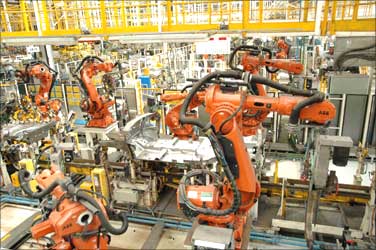 | « Back to article | Print this article |
This is what India needs for 10% growth rate
The Reserve Bank of India Governor says he is maintaining "an anti-inflation stance".
That is understandable. But he also says other things: the current account deficit is unsustainable, the fiscal deficit too high, the overseas debt too large, and credit growth too rapid.
Put it all together and the message can only be that the economy has to slow down.
The usual way in which a large gap between imports and exports is bridged is by slowing demand, for both domestic and imported products, by raising the cost of money.
Click NEXT to read on . . .
This is what India needs for 10% growth rate
Similarly, there is only one way to slow down credit growth from the 24 per cent so far this year, to the RBI's desired level of 20 per cent: raise interest rates. That will dampen demand for everything from housing and cars to fresh capital equipment.
Companies that can't borrow domestically, in the quantity and at the price they want, look to borrow overseas.
But if the external debt is too large (and India's ratio of external debt to GDP is more than twice or thrice the level of most other developing economies), fresh overseas borrowing too will have to be squeezed.
Click NEXT to read on . . .
This is what India needs for 10% growth rate
Finally, there is the fiscal deficit, which is scheduled to drop from 5.5 per cent of GDP this year to 4.8 per cent next year -- without the cushion of this year's bonanza from the spectrum auction (which fetched 1.5 per cent of GDP).
Add the burden of 30 per cent higher daily wage payments under the rural jobs guarantee scheme, a higher subsidy on oil and fertiliser because of rising world oil prices, and the cost of new entitlements like the right to food.
Given these demands on the fisc, the deficit contraction due next year will be a stretch. It could be done if petroleum product prices are raised, but that seems unlikely with Jaipal Reddy as petroleum minister.
Click NEXT to read on . . .
This is what India needs for 10% growth rate
In any case, higher fuel prices will also fuel inflation, and spur further monetary action by the RBI (which most analysts already expect in March and beyond).
In short, if this year's GDP growth ends up at 8.5 per cent, it would be unrealistic to expect more than 8 per cent next year -- especially since there will be no agricultural kicker, and no advantage of a set of low base-year figures.
Even 8 per cent may be achievable only with a normal monsoon and other favourable factors. That wouldn't be bad going, but it is not the 9-10 per cent growth for 2011-12 that the prime minister forecast earlier this month (at the Pravasi Bharatiya Divas).
Click NEXT to read on . . .
This is what India needs for 10% growth rate
Bear in mind that industrial growth in the latest four months for which data are available (August-November) was no more than 6.5 per cent.
The government's chief economic adviser has already said that the months from December will see even worse growth numbers for industry.
Although the RBI in its assessment has pointed to other data (strong credit growth, good indirect tax collections and so on) to assert that "the risk to growth is on the upside," the over-all scenario suggests the opposite; what we may be staring at is a slowdown.
Click NEXT to read on . . .
This is what India needs for 10% growth rate
For the last few years, the assumption in much of the economic discourse has been that India is on an assured path of rapid growth.
That does seem true, but the future may see nothing better than the average growth of the last eight years (8.4 per cent); possibly less.
For 9-10 per cent growth, the system needs what the government has been fighting shy of: further reform measures to free up markets, vastly improved delivery of services by the government (like public health), proper physical infrastructure, and much less corruption.






